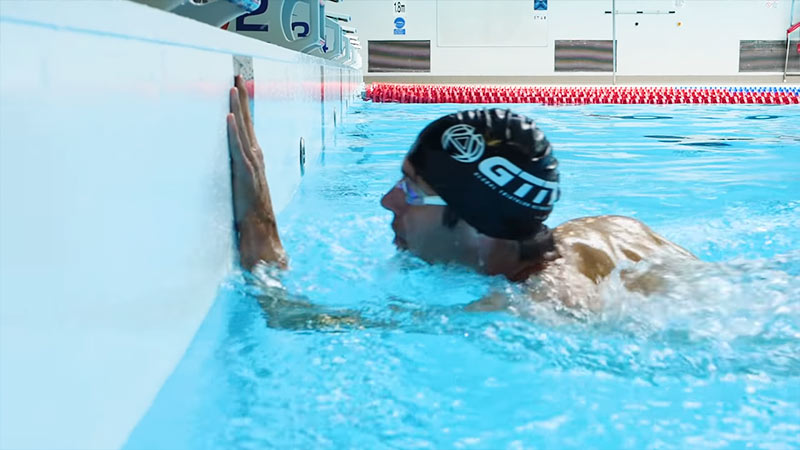The allure of swimming on a sunny day is undeniable, but have you ever noticed that your skin appears darker after a dip in the pool or the sea?
Understanding why your skin changes color after swimming is not just a matter of aesthetics; it’s about comprehending the fascinating science behind it.
In our blog post, “Why Do I Get Darker After Swimming,” we’ll delve into the mechanisms at play.
The sun, the water, and your skin’s natural defense mechanisms are all part of the story.
We’ll explore how UV rays interact with your skin during water activities and the role of melanin, the pigment responsible for your skin color.
Additionally, we’ll share tips on how to enjoy swimming safely while protecting your skin from potential damage.
Prepare to embark on a journey into the world of post-swim skin transformations and discover how science and sun protection come together for a sun-kissed glow that’s both beautiful and healthy.
Why Do I Get Darker After Swimming?
After swimming for a long time, many of you often ask whether does swimming darken skin or not.
In this case, the answer question also comes as a common one that is about whether does indoor swimming causes tanning.
Getting darker after swimming is often due to increased exposure to sunlight, which triggers the production of melanin in the skin.
When you swim, especially in open water like the sea or a pool, the sun’s ultraviolet (UV) rays penetrate the water, intensifying your sun exposure.
This leads to a natural defense mechanism in your body: the production of melanin, a pigment responsible for skin color.
As melanin production increases, your skin darkens, creating a tan. However, this is also the skin’s way of protecting itself from UV damage.
It’s essential to remember that while a tan might seem attractive, excessive sun exposure can cause sunburn, premature aging, and increase the risk of skin cancer.
Therefore, using sunscreen, wearing protective clothing, and limiting your time in the sun is essential to stay safe while enjoying outdoor activities like swimming.
The Effects of Sun and Water on Skin
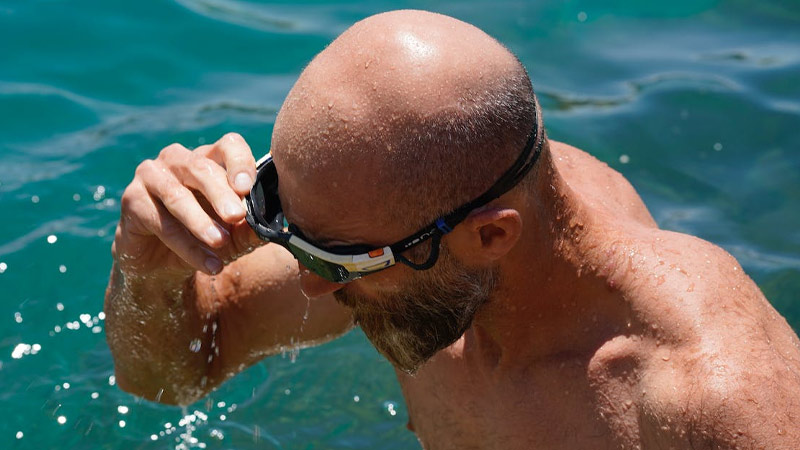
While moderate sun exposure and water can have some positive effects on the skin, excessive or unprotected exposure can lead to a range of skin issues, including sunburn, premature aging, and an increased risk of skin cancer.
Sun Exposure
Sun exposure has both positive and negative effects on the skin. On the positive side, moderate sun exposure helps the body produce vitamin D, which is essential for bone health.
However, excessive sun exposure, especially without proper protection, can lead to sunburn, premature aging, and an increased risk of skin cancer.
UV rays from the sun can damage skin cells, causing wrinkles, fine lines, and pigmentation issues.
Tanning
When exposed to the sun, the skin’s melanocytes produce melanin to protect against UV damage. This natural defense mechanism leads to tanning, which is often sought after for its aesthetic appeal.
However, it’s essential to note that tanning is a sign of skin damage and an increased risk of skin cancer. Artificial tanning methods like tanning beds can be equally harmful.
Water Exposure
Water itself doesn’t typically have direct negative effects on the skin, but the combination of water and sunlight can intensify UV exposure.
When swimming in natural bodies of water or pools, UV rays can penetrate the water’s surface and reach your skin, increasing the risk of sunburn.
Chlorinated pool water can also dry out and irritate the skin, particularly if you don’t rinse off after swimming.
Hydration and Moisturization
Water is vital for skin health from the inside out. Staying hydrated by drinking enough water helps maintain skin elasticity and moisture.
Conversely, prolonged exposure to water, especially in swimming pools, can strip the skin of its natural oils, leading to dryness and potential irritation.
It’s important to use moisturizers to replenish lost moisture and maintain skin health.
Protection and Prevention
To minimize the negative effects of sun and water on the skin, it’s crucial to take preventive measures.
Wear sunscreen with a high SPF rating to shield your skin from UV rays, even when swimming. Additionally, using protective clothing, sunglasses, and wide-brimmed hats can offer extra defense.
After swimming, rinsing off and applying moisturizer can help maintain skin health and hydration.
Factors That Influence Tanning
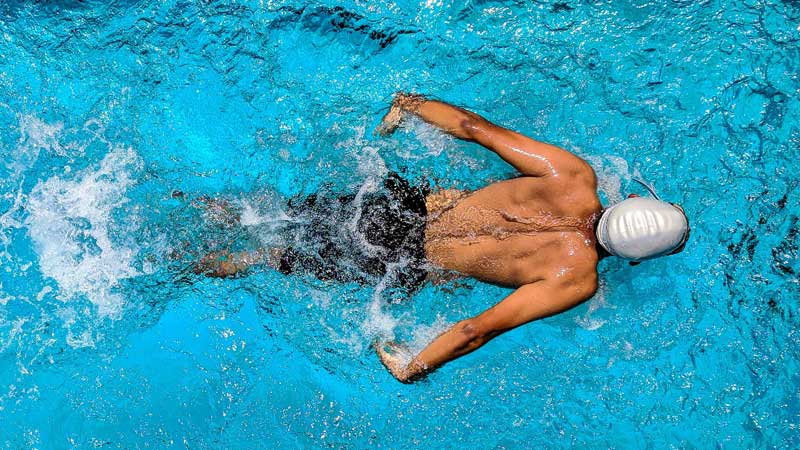
If you are question is, does swimming make your skin darker, you should first learn the factors that come effective in this case.
Several factors influence tanning, determining how your skin responds to sun exposure and the development of a tan.
These factors can vary from person to person and play a crucial role in the tanning process:
Skin Type
The Fitzpatrick scale classifies skin into six types based on its response to UV radiation.
People with lighter skin (Fitzpatrick types I and II) tend to burn easily and have a harder time tanning, while those with darker skin (Fitzpatrick types V and VI) tan more easily and rarely burn.
Skin type is primarily determined by the amount of melanin, a pigment that provides some natural UV protection.
Melanin Content
Melanin, the pigment responsible for skin, hair, and eye color, plays a central role in tanning.
Individuals with higher melanin levels tend to tan more readily and have more natural protection against UV damage. The more melanin in the skin, the darker the tan that can be achieved.
UV Exposure
The intensity and duration of UV exposure directly affect the tanning process.
Spending more time in the sun or under UV lamps can lead to a deeper and longer-lasting tan. However, excessive UV exposure can also result in sunburn and damage to the skin.
Geographic Location
Your geographic location significantly influences your tanning ability.
People living in areas with more direct sunlight, such as those closer to the equator, often have an easier time tanning due to increased UV radiation.
Those living in regions with less sunlight may need more exposure to achieve a tan.
Sunscreen and Protection
The use of sunscreen and protective clothing can hinder the tanning process.
Sunscreen with a high SPF rating blocks UV radiation and reduces melanin production, making it more challenging to tan. Protective clothing, such as long sleeves and hats, can also limit UV exposure.
Medications and Skin Products
Certain medications and skin products can make the skin more sensitive to UV radiation or interfere with the tanning process.
Some antibiotics, acne medications, and perfumes contain compounds that can lead to a higher risk of sunburn and hinder tanning efforts.
Age and Skin Condition
As people age, their skin may become less responsive to UV radiation, making it harder to achieve a tan.
Additionally, skin conditions such as eczema, psoriasis, or sunspots may affect the uniformity and intensity of tanning.
Understanding these factors can help individuals make informed decisions about sun exposure and tanning.
Does Chlorine Darken Skin?

Whether does chlorine water darken skin or not depends on a few factors. Chlorine itself does not directly darken the skin, but its effects on the skin can be misleading in some cases.
Here are a few points to consider regarding chlorine and its impact on skin color:
Temporary Skin Discoloration
Chlorine is commonly used in swimming pools to disinfect the water and kill bacteria. When you swim in a chlorinated pool, your skin may experience temporary discoloration.
This can manifest as a greenish or dull, dry appearance on the skin, especially for people with light skin.
This effect is not true darkening of the skin but rather a reaction between chlorine and substances like sunscreen, sweat, and body oils.
Chlorine and Tanning
Chlorine exposure can potentially affect your tan by drying out the skin. When the skin becomes excessively dry due to chlorine exposure, it can appear dull and less radiant, which can give the impression of darker skin.
However, this is not a true darkening of the skin but a temporary change in skin texture.
Preventing Chlorine-Induced Skin Changes
To mitigate any temporary skin issues related to chlorine exposure, it’s essential to rinse off after swimming in a chlorinated pool and use moisturizers to replenish lost moisture.
Additionally, using a good sunscreen before swimming can help create a barrier between your skin and the chlorine, reducing the likelihood of any skin discoloration.
Skin Health and Sun Protection
While chlorine itself doesn’t darken the skin, it’s important to maintain skin health and protect your skin from the sun when swimming.
Prolonged sun exposure while swimming can lead to tanning and possible sunburn, and combining this with the drying effects of chlorine can exacerbate skin issues.
Always apply sunscreen, wear protective clothing, and practice good skincare to keep your skin looking its best.
Chlorine in swimming pools can have temporary effects on the skin’s appearance, making it seem discolored or darkened, but this is not actual skin darkening.
Tanning Safety in Swimming Pool
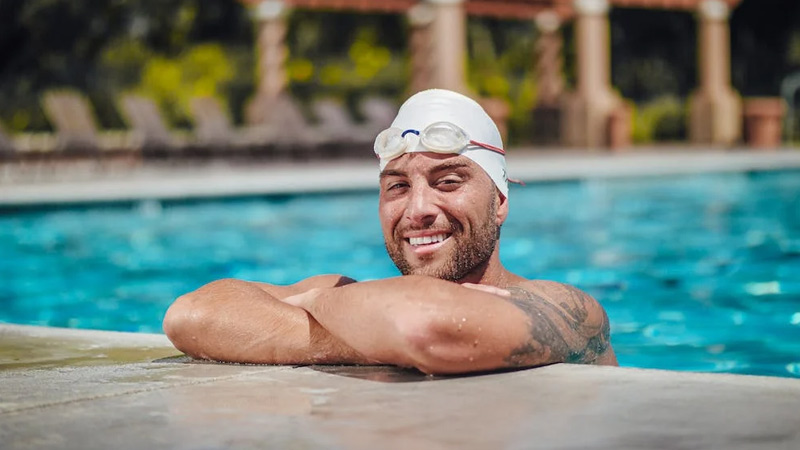
Tanning by the pool can be an enjoyable experience, but it’s crucial to prioritize safety to minimize the risk of skin damage and promote healthy sun exposure.
Here are some safety tips for tanning by the swimming pool:
Sunscreen Protection
Apply sunscreen with a high SPF rating before tanning by the pool. Use a broad-spectrum sunscreen that protects against both UVA and UVB rays.
Reapply it every two hours, or more frequently if you’ve been swimming or sweating. Sunscreen is essential for preventing sunburn and reducing the risk of skin cancer.
Use Shade and Protective Clothing
Seek shade periodically to give your skin a break from direct sunlight.
Wear wide-brimmed hats, sunglasses, and protective clothing, such as long-sleeved shirts and cover-ups, to shield your skin from harmful UV rays.
These measures help prevent premature aging and protect against sunburn.
Avoid Peak Sun Hours
The sun’s intensity is strongest between 10 a.m. and 4 p.m. If possible, limit your poolside tanning during these hours or take extra precautions when the sun is at its peak.
Tanning earlier in the morning or later in the afternoon can reduce your exposure to intense UV radiation.
Stay Hydrated
Tanning can lead to dehydration, so be sure to drink plenty of water to stay well-hydrated.
Dehydration can affect your overall well-being and skin health. Hydrated skin tends to tan more evenly and stay healthier.
Limit Tanning Time
Overexposure to the sun can lead to sunburn, skin damage, and an increased risk of skin cancer. To tan safely, limit your time in the sun.
Start with short intervals, gradually increasing your exposure time as your skin gets used to it. Pay attention to your skin’s signals, such as redness or discomfort, and take a break if needed.
Skin Check and Self-Examinations
Regularly check your skin for any changes, such as new moles or unusual growths.
Performing self-examinations can help detect any skin issues early and prevent skin cancer. If you notice any concerning changes, consult a dermatologist for further evaluation.
Avoid Tanning Beds
Tanning beds emit UV radiation that can be even more harmful than natural sunlight. Avoid using tanning beds, as they are associated with a significantly increased risk of skin cancer and accelerated skin aging.
While tanning by the pool can be enjoyable, it’s essential to prioritize safety and take measures to protect your skin from the harmful effects of the sun.
Post-Swimming Skincare to Get Rid of Dark Skin
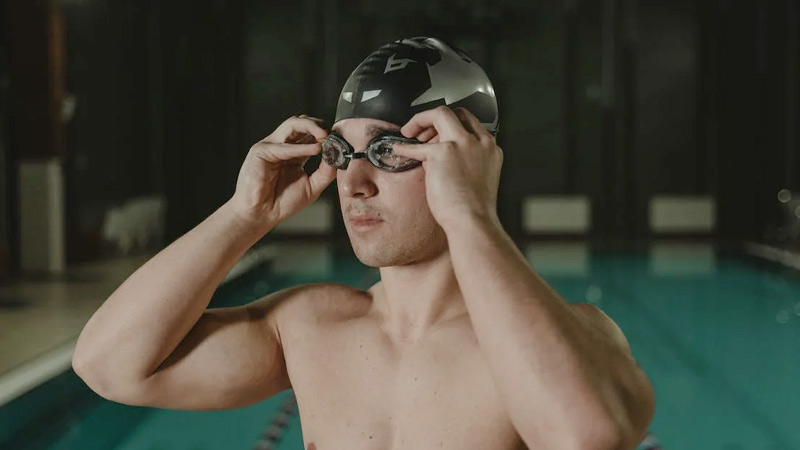
If you’re looking to address darkened skin after swimming and want to restore your skin’s natural tone, here are some post-swimming skincare tips to consider:
Gentle Cleansing
After swimming, it’s essential to rinse off any chlorine or saltwater from your skin. Use a gentle, hydrating cleanser to remove any residues.
Avoid harsh soaps or exfoliants, as these can further dry out and irritate your skin, which may exacerbate the appearance of darkened areas.
Exfoliation
Exfoliating your skin a few times a week can help remove dead skin cells, which can make your skin appear dull.
Choose a mild exfoliant that suits your skin type, whether physical (scrubs) or chemical (products containing alpha hydroxy acids or beta hydroxy acids).
Exfoliating can promote a more even skin tone and reveal brighter skin.
Moisturize
Keeping your skin well-hydrated is essential for maintaining an even skin tone and addressing darkened areas.
Use a moisturizer that’s suitable for your skin type, and consider products containing ingredients like hyaluronic acid or glycerin for extra hydration.
Moisturizing can help improve skin texture and reduce the appearance of dry or flaky skin.
Sunscreen
Even after swimming, it’s crucial to continue protecting your skin from the sun’s harmful UV rays.
Applying sunscreen with a high SPF rating is essential to prevent further darkening of the skin and to protect against sunburn and long-term sun damage.
Reapply sunscreen throughout the day, especially if you’re spending more time outdoors.
Skin Brightening Products
Consider using skin brightening or lightening products with ingredients like vitamin C, niacinamide, or licorice extract.
These ingredients can help reduce the appearance of dark spots and promote a more even skin tone. Be patient, as it may take several weeks to see results.
Consult a Dermatologist
If you have persistent darkened areas on your skin that do not improve with over-the-counter products, it’s advisable to consult a dermatologist.
They can provide professional guidance and recommend treatments like chemical peels, laser therapy, or prescription-strength skin lightening products if necessary.
Remember that achieving an even skin tone may take time and consistent care. Additionally, individual results can vary based on your skin type and the cause of the darkening.
FAQs
Does swimming at night cause tanning?
Swimming at night doesn’t cause tanning because tanning is primarily a result of exposure to UV rays from the sun. Nighttime swimming, in the absence of sunlight, won’t tan your skin.
Does chlorine make your skin darker?
Chlorine itself doesn’t make your skin darker. However, prolonged exposure to chlorinated water may cause skin dryness and sensitivity, potentially accentuating existing skin imperfections.
Will my skin color come back after swimming?
Your skin color typically returns to its natural shade after swimming once you thoroughly rinse off chlorine and moisturize your skin. Swimming alone doesn’t permanently change your skin color.
Does chlorine darken your skin after using the pool?
Chlorine can make your skin dry and potentially accentuate existing imperfections, but it doesn’t typically darken your skin. Proper skincare can help mitigate any negative effects of chlorine exposure.
When does chlorine make skin dark?
Chlorine doesn’t inherently darken your skin. However, if you don’t rinse off chlorine after swimming or if your skin is sensitive to it, prolonged exposure may make your skin appear dry or irritated.
Wrapping Up
As we conclude our exploration of why your skin appears darker after swimming, it’s evident that the sun’s interaction with your skin during water activities is a fascinating interplay of science and nature.
While a tan may be a desirable result of outdoor water fun, it’s crucial to remember that sun protection is your skin’s best friend.
Taking steps to protect your skin, such as applying sunscreen, wearing protective clothing, and being mindful of sun exposure, can help you achieve that golden glow, premature aging, and skin damage.
Embracing these practices allows you to enjoy the beauty of a healthy, radiant complexion without compromising your skin’s well-being.
So, the next time you take a dip, do so with an understanding of the science involved, and an unwavering commitment to keeping your skin safe and beautiful for years to come. Thank you.

